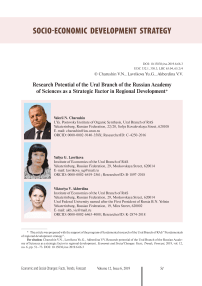Research potential of the Ural branch of the Russian Academy of Sciences as a strategic factor in regional development
Автор: Charushin Valerii N., Lavrikova Yuliya G., Akberdina Viktoriya V.
Журнал: Economic and Social Changes: Facts, Trends, Forecast @volnc-esc-en
Рубрика: Socio-economic development strategy
Статья в выпуске: 6 (66) т.12, 2019 года.
Бесплатный доступ
The article brings to the fore the issues related to identifying and assessing the relationship between the development of the research sector and the innovative growth of regions. It is shown that the key feature of the knowledge generation sector is research potential, the essence of which is directly related to the level of development of fundamental and applied research, the degree of their implementation in the material sector of the economy. We reveal that at present the research is carried out, which affects various aspects of the assessment of research potential, identifying the trends in its development and mechanisms of its implementation at different levels. The comparative analysis carried out in the article shows that all methodological approaches include a fairly identical set of indicators characterizing quantitative characteristics and their dynamics; many of them use aggregated indices that make it possible to compare countries and regions. In addition to the existing methods, our own approach proposes to analyze not only quantitative, but also qualitative characteristics in order to create conditions for the formation of the environment for innovative development of the region. Thus, on the example of the Ural Branch of the Russian Academy of Sciences we show that the priority directions of research development should not only correspond to the global and national scientific agenda, but also address the issues of innovative development of the regions in which research centers are located. The article presents the analysis of the regions in which scientific institutes and centers of the Ural Branch of RAS are located; we make a classification of these regions, highlighting the regions-innovators, regions-followers and catching up regions; priorities of innovation and technological development are identified for each region and then they are compared with the priorities of the Ural Branch of RAS. We put forward the thesis that in addition to the concentration of researchers the most important condition for the generation of knowledge and for the creation of breakthrough technologies is a high concentration of investment resources in the field of science. On the example of the Ural Branch of the Russian Academy of Sciences we present the data on the need for investment in the development of scientific organizations and scenarios for their development.
Research potential, factors in the development of the region, ural branch of ras
Короткий адрес: https://sciup.org/147224243
IDR: 147224243 | УДК: 332.1, | DOI: 10.15838/esc.2019.6.66.3
Текст научной статьи Research potential of the Ural branch of the Russian Academy of Sciences as a strategic factor in regional development
The innovative development scenario for Russia is non-alternative: it has been repeatedly proved by scientists and economists, and it is enshrined in federal and regional legal acts. The implementation of this scenario should ensure a high level of the domestic economy’s competitiveness in the world. Usually, researchers identify a number of characteristics natural for an economic innovation model. Among them, the key ones are the high level and quality of human capital, significant investments in its development, well-organized and effectively functioning innovation systems, an attractive investment climate, and a high share of high-tech sectors in the structure of the economy. Moreover, the most important component is the research potential of the economy, the content of which is associated with a high level of fundamental science development, significant rates of implementation of applied science’s results, the presence of major scientific centers. It is generally accepted that the efficient functioning of the innovative model of economic development is impossible without a proper development level of the scientific sphere. Research potential plays a key role in this context for current and future innovative development1.
The role of science in the process of the innovative environment shaping is often reviewed from completely different positions. Each point of view highlights and considers a specific feature. Thus, according to some interpretations of the research potential, the emphasis is put on the content of the concept, according to others – on its functionality, according to some more – on the characteristics of relationships with other economic sectors2, etc. It seems appropriate to justify the methodological choice for objectives of this study without conducting a detailed analysis of all existing concepts.
Many researchers use a general and broad concept of “intellectual potential” . They understand it as scientific knowledge in general, which includes knowledge embodied in the results of intellectual activity (technologies, patents, etc.), knowledge which has a significant informational nature (publications), and knowledge which is inseparable from a person. From this point of view, the assessment of intellectual capital is given by the OECD: it separately considers the level of educational potential and the level of development of scientific research3. In this sense, intellectual potential characterizes the ability of a country (region) to create new knowledge and technologies for its socio-economic development4.
The term “educational scientific potential” is quite close to intellectual potential. It is usually understood as a set of educational, scientific, scientific and educational country’s institutions. Spatial structure of scientific and educational potential plays a key role in the formation of policy of “regional inequality” alignment. It becomes a major factor of strengthening regional competitive advantages through the formation and development of human capital, creation of regional scientific and educational infrastructure, institutional environment of the regional innovation system. This concept is closely related to activities specified in national “Science” project on creation of regional networks of scientific and educational centers.
The term “scientific and technical potential” is one more concept reviewing the knowledge generation sphere from the position of technology creation. Thus, according to some researchers, scientific and technical potential is the “unity of two primary characteristics: 1) the totality of resources related to the scientific and technical sphere; 2) effectiveness of functioning, especially in terms of impact on the economy and society as a whole”5. Another opinion connects the scientific and technical potential with “the totality of human, material, financial and informational resources available to the national “science-technology” sphere and organizational and managerial structures that ensure the functioning of this sphere”6. Literally, scientific and technical potential is a complex system that includes scientific (research and development), educational, and technical potential. A number of researchers review scientific and technical potential very narrowly: as the result of research and development, defined by the quantity of scientific and technical information; as the result of scientific activities and studies’ types which are directly related to the creation of new technology and the development of new scientific and technical projects, programs7,8.
The imposition of research potential on the sphere of innovative products manufacturing leads to the emergence of the “ innovative potential ” concept. It is the result of the transformation of scientific knowledge into new types of products and services9, organizational, managerial, and financial mechanisms10 aimed at creation of multiplicative innovations11. An integral part of the innovative potential is an array of scientific and technical developments, inventions necessary for the formation of accelerated growth of innovative products’ manufacturing. Mechanisms of formation and use of innovative potential are directly connected with the increase of quality level and demand of R & D, the improvement of cooperation between industrial enterprises and organizations of fundamental and branch science, the formation of an intellectual property market12.
We focus on “research potential” which we understand as the totality of scientific knowledge, results of fundamental and applied scientific research obtained at different stages of the scientific and technical cycle. Research potential, being part of scientific and technical potential, is focused on early stages of the scale of technology readiness, connected with fundamental and applied studies, which include “approval and publication of basic technological principles; formulation of the technology concept and evaluation of the application scope; start of research and development, confirmation of characteristics; verification of main technological components in the laboratory; verification of main technological components in real environment»13. Respectively, drivers of the research potential formation are scientific organizations that carry out fundamental and applied studies.
As mentioned earlier, usually, in publications, research potential is not allocated to an independent category with a corresponding definition and a set of characteristics, but it is included, as an integral element, in scientific and technical potential. At the same time, research potential is the basis for the development of scientific and technical, innovative potential in the country and on the regional level. It ensures the competitiveness of produced goods and services14. Identification and evaluation of research potential are justified by the purpose of this article, which is to show the role of organizations, performing research and development, in the innovative development of regions and countries.
Country’s research potential is spatially distributed , and its formation is primarily connected with a functional role in regional development. It is the regional level of innovative systems that ensures the absorption of technological knowledge15, forms the susceptibility of innovation by industries, multiplicatively increases the production of innovative products16. Region’s research potential has a paramount importance for achieving a given level of innovative development of the regional socio-economic system, corresponding to the tasks of postindustrial development. It also acts as a powerful non-material factor of region’s innovative environment, the formation and development of which is largely provided by the usage of fundamental and applied science’s achievements.
In this regard, the article aims to emphasize the key role of regional science in the innovative and socio-economic development of regions, connected, on the one hand, with the solution of regional problems, and, on the other hand, with inclusion in global scientific agenda, which ensures region’s competitiveness in global economy.
Research methodology and justification of its choice
There is no independent system of indicators of research potential assessment in international practice. Usually, research potential is included in the composite index of innovative development. Methods for evaluating indicators that allow assessing the level of development of the innovative potential of the economy (as well as its individual components) are quite diverse. The Organization for Economic Cooperation and Development (OECD), which proposed the Declaration on Science, Technology, and Innovation Policies for the Global and Digital Age17 in 2015, is the legislator for the assessment and monitoring of scientific and innovative development. Meanwhile, other methods of comparison of scientific and innovative activity by composite indices, which allow a comprehensive assessment of an analyzed area, deserve attention. In particular, we are interested in the section of methods related to the assessment of research potential.
Russian practice, usually, copies foreign approaches and evaluates the country and regions according to above-mentioned methods24. At the same time, there are separate methods for evaluating research potential in the fields of federal regulation (FSMNO)25 and scientific community26.
Most Russian and foreign methodologies have several limitations in the process of assessing region’s research potential. Some of them are purely technical: they do not allow calculating individual indicators on the regional level. However, there are also fundamental problems: for example, the lack of assessment of research topics’ relevance and its compliance with global or national scientific agenda, the lack of connection of research potential with indicators of regions’ socio-economic development, the lack of evaluation of research cooperation and collaboration.
Our approach toward assessment of research potential allows consideration of above-mentioned aspects and clear justification of science’s strategic role in the regional development. This approach also includes the comparison of indicators per researcher, not only the analysis of absolute indicators. It lets us comparatively analyze regions with each other and notice deviations from best regions (benchmarks) and average Russian values.
Characteristics of studies’ object and data sources
The object of the article’s research is research potential of Ural Branch of RAS. Today it is a powerful multi-industry research complex, which has 33 scientific organizations, a number of universities, the largest scientific library in the Urals, design, technology, engineering centers, and a network of hospitals under its scientific and methodological guidance. Academic research organizations are situated in Yekaterinburg, Syktyvkar, Izhevsk, Perm, Chelyabinsk, Arkhangelsk, and Orenburg. They include more than 3700 scientists, almost 750 doctors, and more than of science controlling. Ekonomist=Economist, 2019, no. 2, pp. 45–58.;Yur’evich M.A. Ratings of scientific organizations. Sociologiya nauki i tekhnologii=Sociology of Science and Technology, 2018, vol. 9, no. 4, pp. 66–79.
2000 candidates of sciences. Researchers under the age of 39 make up 42% from the number of all researchers. 36 academicians and 67 corresponding members of the Russian Academy of Sciences supervise studies in the most important scientific areas. Every year, researchers prepare more than 4 thousand publications ( Fig. 1 ). There is a doctorate, and the post-graduate school trains students in 83 specialties.
More than a half of the scientific output of the Ural region is created in academic institutions under the scientific and methodological guidance of the Ural Branch of the Russian Academy of Sciences. These organizations are popular scientific complexes, the volume of research and development of which increases every year ( Fig. 2 ). The educational segment in the institutes of Ural Branch of RAS develops quite dynamically.
Figure 1. Dynamics of publishing activity of institutes of Ural Branch of RAS

4611 4586 4630

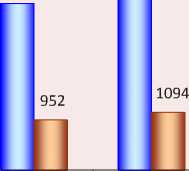
3129 3087 3098
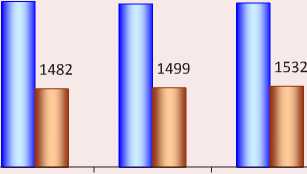
2016 2017 2018
2013 2014 2015
Russian publications
■ _ _ ■ Foreign publications —•— OVERALL
Source: Ural territorial administration of the Ministry of Science and Higher Education of the Russian Federation.
Figure 2. Dynamics of research and development extent of institutes of the Ural Branch of RAS, million rubles
7.00

6.50
6.00
5.50
5.00
4.50
2014 2015 2016 2017 2018
Source: Ural territorial administration of the Ministry of Science and Higher Education of the Russian Federation.
Figure 3. Dynamics of labor productivity of the Ural RAS institutes, thousand rubles
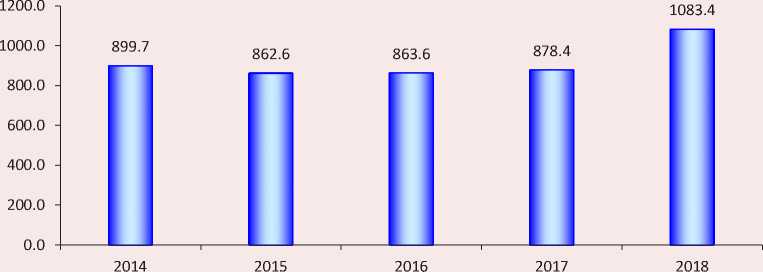
Source: Ural territorial administration of the Ministry of Science and Higher Education of the Russian Federation.
Thus, from 2014 to 2018, the volume of educational services (post-graduate studies) has increased by 2 times.
The dynamics of labor productivity (the ratio of the financial performance of a scientific organization by type of work performed and services rendered to the average number of employees) in the institutes of the Ural Branch of RAS constantly increases. At the end of 2018, it was just over 1 million rubles per employee ( Fig. 3 ).
The largest share in the volume of financial performance of organizations of Ural Branch of RAS is occupied by institutions located in Yekaterinburg. They account for 52.6% of government tasks funding, 55.2% of researchers’ number and almost 60% of scientists under the age of 39.
In order to unite research potential of academic institutes under scientific and methodological management of Ural Branch of RAS, the complex system of federal research centers (FRC) was formed: Federal Center for Integrated Arctic Research of the Russian Academy of Sciences named after academician N.P. Laverov, Perm Federal Research Center of the Ural Branch of RAS, Udmurt
FRC of UB RAS, Komi FRC of UB RAS, Orenburg FRC of UB RAS, South Urals FRC of Mineralogy and Geoecology of UB RAS, Ural Federal Agricultural Research Center of UB RAS.
Scientific institutions of the Ural Branch of the Russian Academy of Sciences conduct fundamental and problem-oriented studies aimed at the implementation of critical technologies, included in federal target programs, Presidium programs, grants from domestic and foreign funds ( Fig. 4 ). Many scientific and practical developments are carried out together with universities, sectoral institutes, industrial enterprises, militaryindustrial organizations.
Main areas of research are related to theoretical and applied mathematics and mechanics, control processes, solid state physics and chemistry, electro- and thermosphysics, thermal engineering, integrated engineering, theory of metallurgical processes, high temperature electrochemistry, synthetic organic chemistry, population ecology, immunology, genetics, an integrated study of plant, animals, water, and soil resources, geological study of the territory,
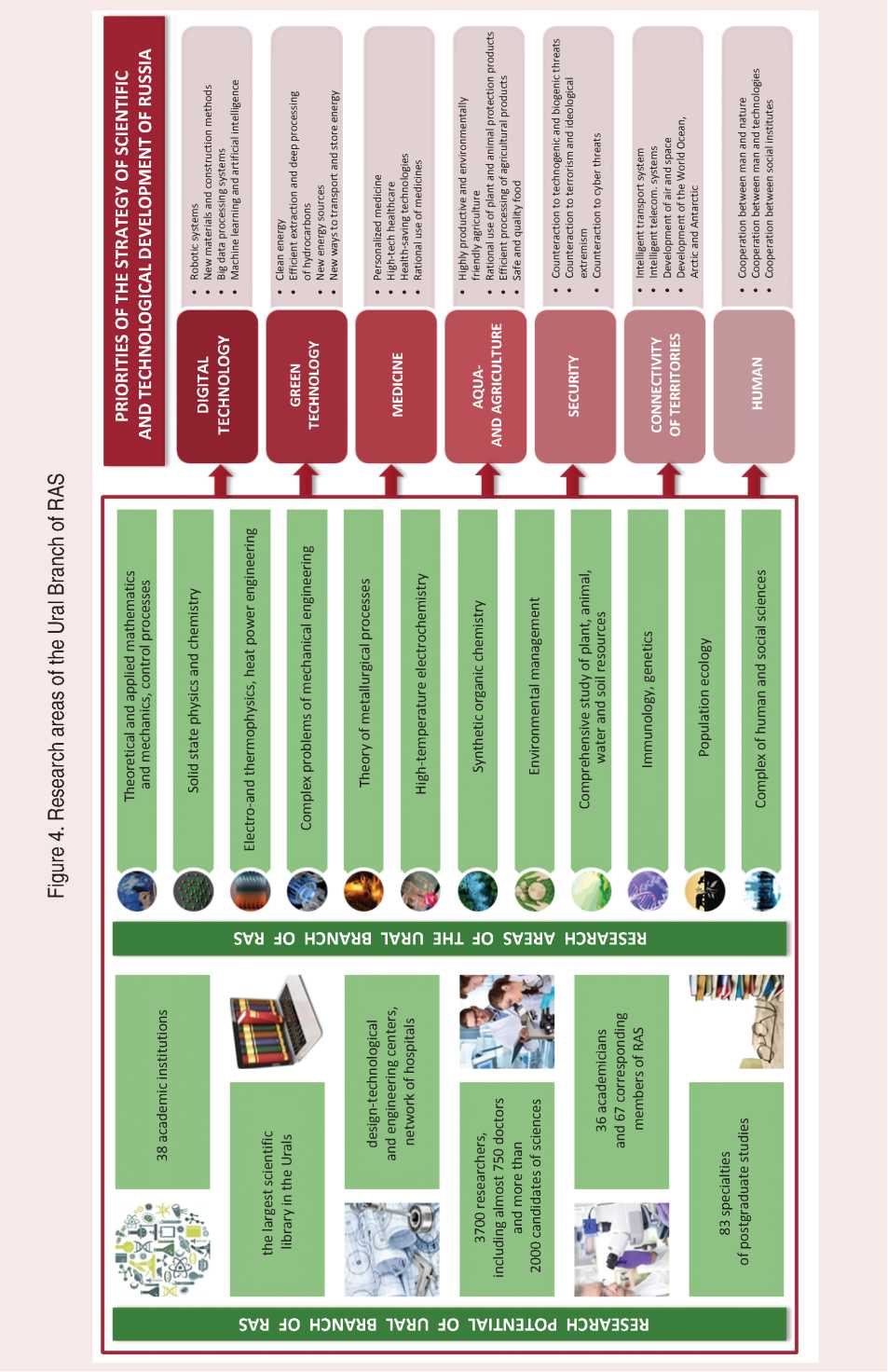
the identification of mineral deposits and establishment of foundations of rational nature management, development of mineral resources, the complex of sciences on man and society. Formation of directions is caused by peculiarities of historical academic science development in the Urals and needs of one of the largest industrial regions.
Historically organized areas of scientific studies of the Ural Branch of Russian Academy of Sciences fully correspond to the priority directions of Russian scientific-technological and social development and meet the needs of country’s largest industrial regions : first and foremost, regions with scientific centers of UB RAS.
We used data from the Ural territorial administration of the Ministry of Science and Higher Education of the Russian Federation and the Federal state statistics service for assessing the research potential of the Ural Branch of RAS, and its impact on socioeconomic development of the regions of its presence.
Results of the research
Scientific institutions and departments of the Ural Branch of RAS are situated on the territory of three federal districts of the Russian Federation (Ural, Volga, and Northwestern), two economic regions (Northern and Ural), two republics (Udmurt and Komi), one krai (Perm), and five oblasts (Sverdlovsk, Chelyabinsk, Orenburg, Arkhangelsk, and Kurgan). Ural RAS organizations are situated on territories of so-called middle regions, which serve as indicators of country’s socioeconomic development in spatial aspect at the expense of network inter-territorial and global cooperation. It also determines strategic scientific status of the Ural Branch of RAS as the center of scientific studies coordination, including interdisciplinary.
On the one hand, the prospective development of scientific research in the Ural RAS should meet the needs of regions where the Department’s scientific organizations are located. On the other hand, the search work should not be limited by regional orientation but should include the study of general laws of nature and society development that are important for Russian and global science.
Regions with scientific institutes of Ural RAS are industrial Russian territories, which have unique natural resource potential in terms of reserves and diversity, a developed industrial complex, powerful, although unevenly developed, transport and energy infrastructures, a high export potential of its products, qualified labor resources, extensive network of educational and research centers. The regions are extremely rich in various minerals, national importance have ferrous and nonferrous metallurgy, manufacture of machinery, equipment and technology a wide spectrum (from the shopping and transport equipment to construction equipment, drilling and metallurgical plants, chemical equipment, electronics and automation, nuclear power), chemical production, mining of minerals, harvesting and processing of wood. The regions are extremely rich in various minerals: ferrous and non-ferrous metallurgy, manufacture of machinery, a wide spectrum of equipment and technology (from the shopping and transport equipment to construction equipment, drilling and metallurgical plants, chemical equipment, electronics and automation, nuclear power), chemical production, mining of minerals, harvesting and processing of wood have national importance.
Regions with the Ural RAS scientific institutions are extremely heterogeneous in terms of scientific status, innovation activity, and economic structure.
Regions-innovators are quite clear: Sverdlovsk and Chelyabinsk oblasts, Perm krai. These regions significantly differ from other entities in terms of internal expenditures on research and development: in absolute terms and in GRP percentage (Fig. 5, 6).
35.0
30.0
25.0
20.0
15.0
10.0
5.0
0.0
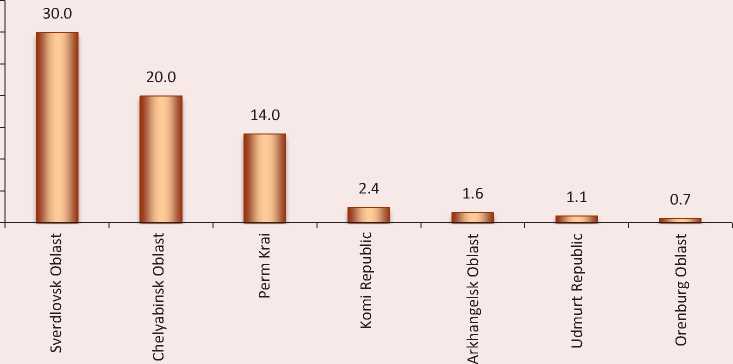
Source: Russian regions. Main characteristics of entities of the Russian Federation-2018: stat. coll. Federal State Statistics Service. Available at: (accessed: 20.11.2019).
Figure 6. Expenditures in regions with research centers of the Ural Branch of RAS in 2018, in % to GRP
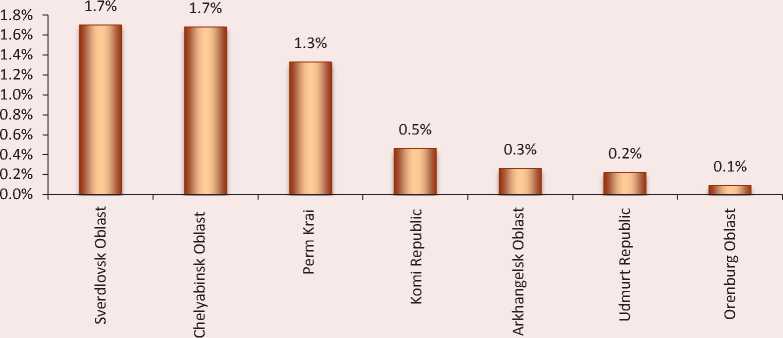
Source: Russian regions. Main characteristics of entities of the Russian Federation – 2018: stat. coll. Federal State Statistics Service. Available at: (accessed: 20.11.2019).
Figure 7. Volume of innovative products in regions with research centers of the Ural Branch of RAS in 2018, billion rubles
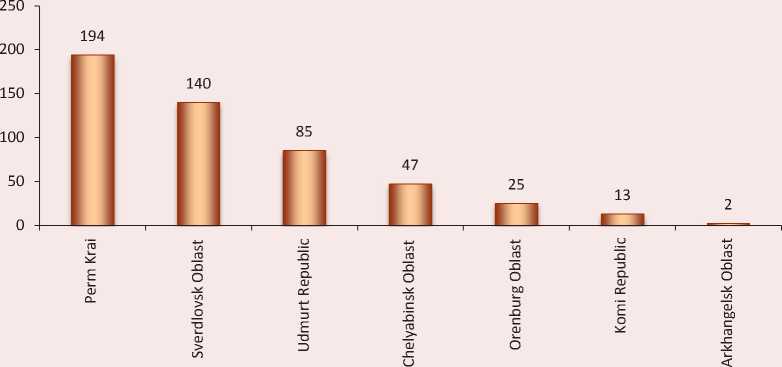
Source: Russian regions. Main characteristics of entities of the Russian Federation – 2018: stat. coll. Federal State Statistics Service. Available at: (accessed: 20.11.2019).
Figure 8. The share of products of high-tech and knowledge-intensive industries in GRP, %
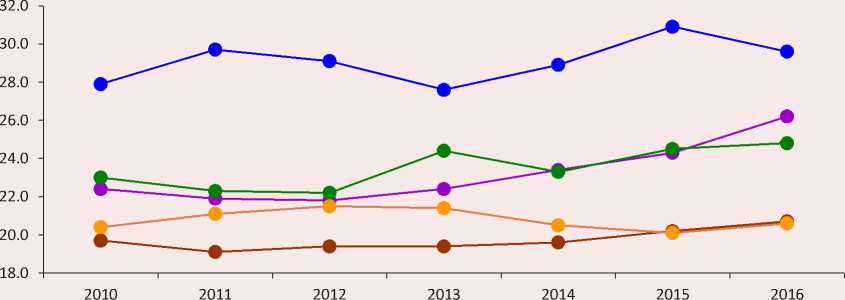
—•— Russian Federation
—•— Perm Krai
—•— Chelyabinsk Oblast
—•— Udmurt Republic
—•— Sverdlovsk Oblast
Source: Russian regions. Main characteristics of entities of the Russian Federation – 2018: stat. coll. Federal State Statistics Service. Available at: (accessed: 20.11.2019).
The volume of shipment of innovative products is also significant ( Fig. 7, 8 ). It is related to a large share of high-tech sector in these regions, which, primarily, include mechanical engineering, chemical and pharmaceutical industry, energy, and militaryindustrial complex. Thus, foreground studies in regional Ural RAS scientific divisions depend on priorities of their technological development:
– in the Sverdlovsk Oblast – the development of informational technologies (computing resources, storage and transmission of information), alternative sources of energy, energy saving, resource-saving and environmentally friendly technologies for mining and deep processing of mineral and man-made raw materials, materials science, organic synthesis, development of new materials, technologies of mechanical engineering, instrumentation, chemical industry, development of high-tech agricultural production, etc.;
– in the Chelyabinsk Oblast – scientific support of priority areas of technological development (rocket and space technology, nuclear power, instrument-making), new technologies for the synthesis of inorganic materials, strengthening of raw material base for mining and metallurgical industry;
– in Perm Krai – scientific support of oil and gas complex transition to new technologies for production and processing of fuel, increase of depth of raw materials processing in forest, chemical, and petrochemical industries, improvement of environmental friendliness in mentioned industries, development of high-tech machine-building products, construction of materials, and development of innovative infrastructure for creation and implementation of new biotechnologies in areas of environmental protection, industry, medicine, and agriculture.
Scientific research at the Ural RAS institutions, located in these regions, have their own unique directions and significant reserves for advancement in global scientific space.
The next group of regions is called “ regions-followers ”, which differ in average values of scientific, technological, and innovative development. It includes Republics of Komi and Udmurtia, as well as the Arkhangelsk Oblast. Thus, research areas are more closely related to development needs of these regions: some areas have a global potential.
The Orenburg Oblast is one of catching up regions with low innovative activity. At the same time, there is an ongoing in-demand research on creating a network of seismic monitoring, development of new diagnostic and therapeutic technologies, and justification of geo-ecological basics of sustainable nature management in a steppe zone.
According to the Forecast of a long-term socio-economic development of the Russian Federation for the period up to 2030, the highest growth rate of GRP is projected in the Sverdlovsk (308%), Chelyabinsk (209%), and Tyumen (200%, without Autonomous okrugs) oblasts. It will be caused by the placement of new production facilities and expected high level of investment in southern regions of the Ural Federal district.
The commissioning of new fields in Yamalo-Nenets Autonomous Okrug will allow maintaining a fairly high rate of GRP growth (199%) up until 2030, but Khanty-Mansi Autonomous Okrug is expected to lose GRP: by 2030, the figure will have reached only 90% of 2011 level. Sverdlovsk (364%), Kurgan (306%), Tyumen (without Autonomous okrugs) (254%), and Chelyabinsk (200%) oblasts will be leaders of industrial growth in 2012–2030 period.
High rates of investment growth are caused by capital intensity of projects in extractive and infrastructure industries: they account for a significant part of regional investments. Sverdlovsk (323%) and Chelyabinsk (223%) oblasts are leaders in terms of district’s investment growth. However, according to absolute investment volumes, Yamalo-Nenets and Khanty-Mansi Autonomous okrugs prevail: major volume of Ural Federal District’s investments will be send into these economies.
Table 1 presents separate indicators of regions’ research potential with scientific centers of the Ural Branch of RAS. As mentioned earlier, scientific organizations are drivers of research potential. Main scientific organizations, which carried out research and development, are located in the Sverdlovsk oblast, Perm Krai, and the Chelyabinsk Oblast. These regions also lead in terms of research and development costs. At the same time, the Chelyabinsk Oblast, the Komi Republic, and the Orenburg Oblast are leaders in terms of budget funding share. At the same time, in terms of per capita indicators (per 1 employee who performed research and development), regions with a smaller number of researchers are in the lead ( Fig. 9 ).
Table 2 shows normalized values of indicators included in author’s methodology for assessing regional research potential. Normalization of indicators’ values is based on the assessment of deviations from the national average. Sum up of deviations for eight indicators gives an integral assessment of the excess of indicators’ values over Russian average value, on the basis of which regions are grouped into regions-innovators, regions-followers, catching up regions.
In 2019, the Comprehensive plan of development of the Ural Branch of RAS up to 2025 was developed and approved. It states the mission of the Ural Branch of RAS : fundamental knowledge and highly qualified personnel for innovative development of the Urals, adjacent regions, and Russia.
In May of 2018, aims and objectives of national “Science” project were defined by the President’s Decree “On National Goals and Strategic Objectives of the Russian Federation through to 2024”. A Comprehensive plan (Strategy) for the development of the Ural branch of RAS until 2025 will be implemented in this period. The national project “Science” sets clear, specific, and measurable goals, which are certainly reflected in the Strategy of Ural Branch of RAS.
According to this, the aim of the Ural Branch of RAS development is to take scientific research to global level and integrate academic science into the system of innovative renewal of the Ural and Russian economies.
Achievement of stated task will become possible due to completion of strategic tasks ( Fig. 10 ). The Ural department clearly divides strategic tasks concerning the development of presence regions and strategic tasks concerning the development of internal environment of the Ural department. Strategic objectives of the Ural department development correlate with the objectives of the national “Science” project.
On the basis of goals and objectives of the Comprehensive plan for the period until 2025, taking into account clear objectives and specific target parameters articulated in the Russian President’s May decree, Strategy of scientific and technological development of Russia, federal projects within national project “Science”, the state program of the Russian Federation “Development of industry and increase of its competitiveness”, and focus on directions of scientific-technological and industrial development of the Ural region
Table 1. Key performance indicators of organizations that conducted research and development, January – June, 2019
|
Indicators |
DC |
DC |
S. Ё ^ |
о |
5 E => |
Ё ^ E |
o о |
о ей |
о |
|
Number of organizations that carried out research and development, units |
157 |
74 |
24 |
36 |
28 |
59 |
25 |
99 |
53 |
|
Research and development costs – total, million rubles |
14864 |
978.1 |
820.8 |
614. 5 |
1231.1 |
9357.4 |
386.0 |
13479 |
11238 |
|
internal |
12478 |
792.2 |
812.9 |
610.7 |
1184.3 |
8119.3 |
378.9 |
11576 |
10399 |
|
external |
2386 |
185.9 |
7.9 |
3.7 |
46.8 |
1238.2 |
7.1 |
1902.9 |
838.9 |
|
Internal expenses for research and development at the expense of the federal budget, million rubles. |
12954 |
953.7 |
526.2 |
203.9 |
198.9 |
2746.6 |
224.5 |
3063.8 |
8610.4 |
|
*Not including Moscow, Saint Petersburg, the Moscow and Leningrad oblasts. |
|||||||||
Table 2. Normalized values of indicators included in the assessment of the region’s research potential
|
Indicators |
о ей |
о |
Ё Е |
Ё ^ |
о |
Е => |
о о |
|
Expenditure on research and development per 1 researcher |
0.8899 |
0.8735 |
1.1339 |
0.6316 |
0.7301 |
0.7562 |
0.4778 |
|
Salary fund per 1 researcher |
0.6788 |
0.8424 |
0.7662 |
1.2257 |
0.3482 |
0.6584 |
0.2791 |
|
Internal costs for research and development at the expense of the federal budget per 1 researcher |
0.5262 |
1.7408 |
0.8656 |
1.0530 |
0.6303 |
0.3178 |
0.7228 |
|
Share of budget financing |
1.5912 |
1.9928 |
0.7634 |
1.6673 |
0.8633 |
0.4202 |
1.5127 |
|
Share of innovative products |
1.0615 |
0.9538 |
2.8308 |
0.1846 |
0.8615 |
1.9385 |
0.4923 |
|
Patents for inventions per 1 researcher |
1.6806 |
0.4796 |
1.1101 |
0.8500 |
0.4009 |
1.9033 |
0.4000 |
|
Developed technologies per 1 researcher |
1.9833 |
2.9000 |
1.7129 |
0.2719 |
2.5192 |
1.9536 |
0.4374 |
|
GRP per capita |
1.1703 |
0.7556 |
0.8884 |
1.3310 |
1.2558 |
0.7195 |
0.8132 |
|
Amount of variance |
9.5819 |
10.539 |
10.071 |
7.2152 |
7.6092 |
8.6674 |
5.1353 |
|
Type of region |
Regions-innovators |
Regions-followers |
Catching up regions |
||||
Figure 9. Normalized values of indicators of the research sector development in regions of the Ural Branch of RAS
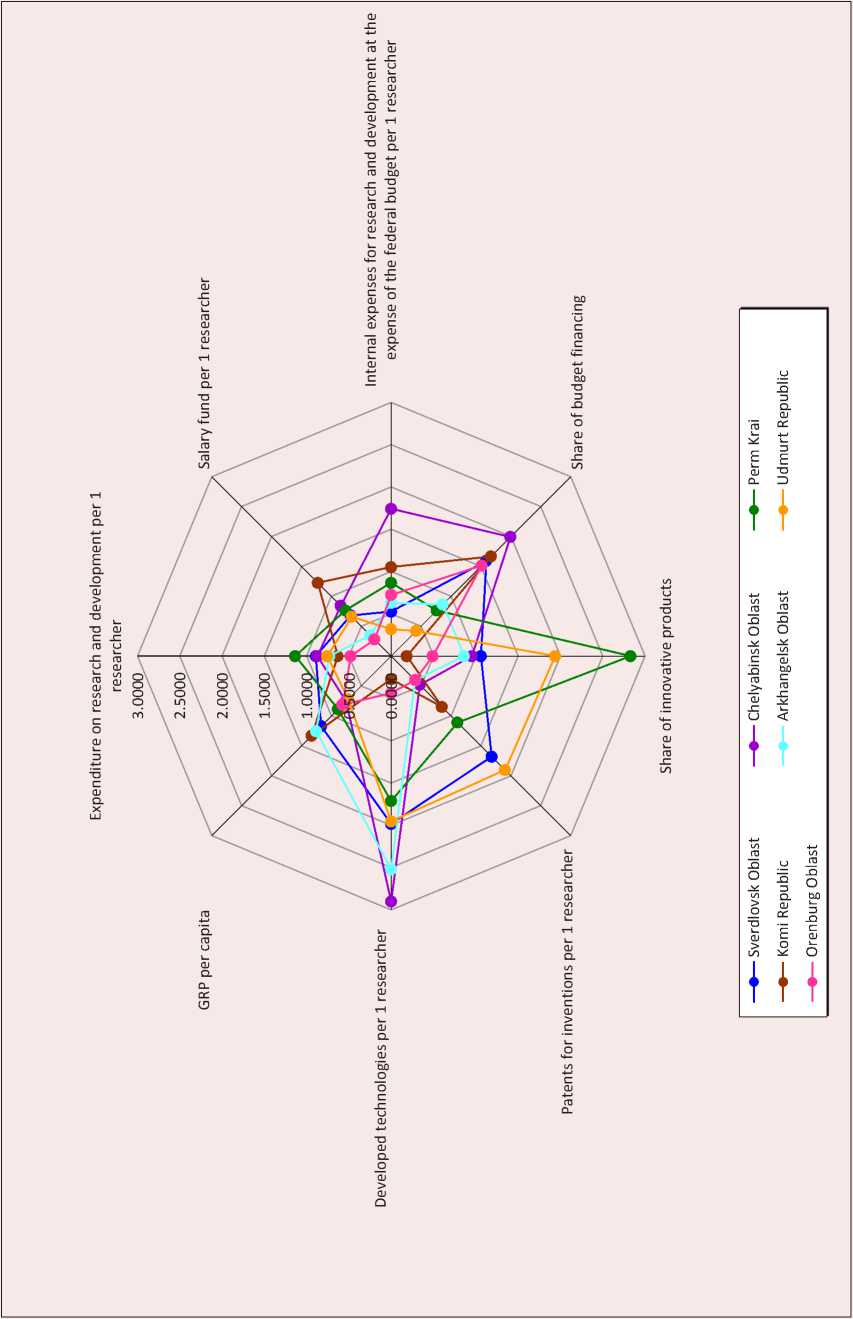
Figure 10. Purpose and strategic objectives of the Ural Branch of RAS development
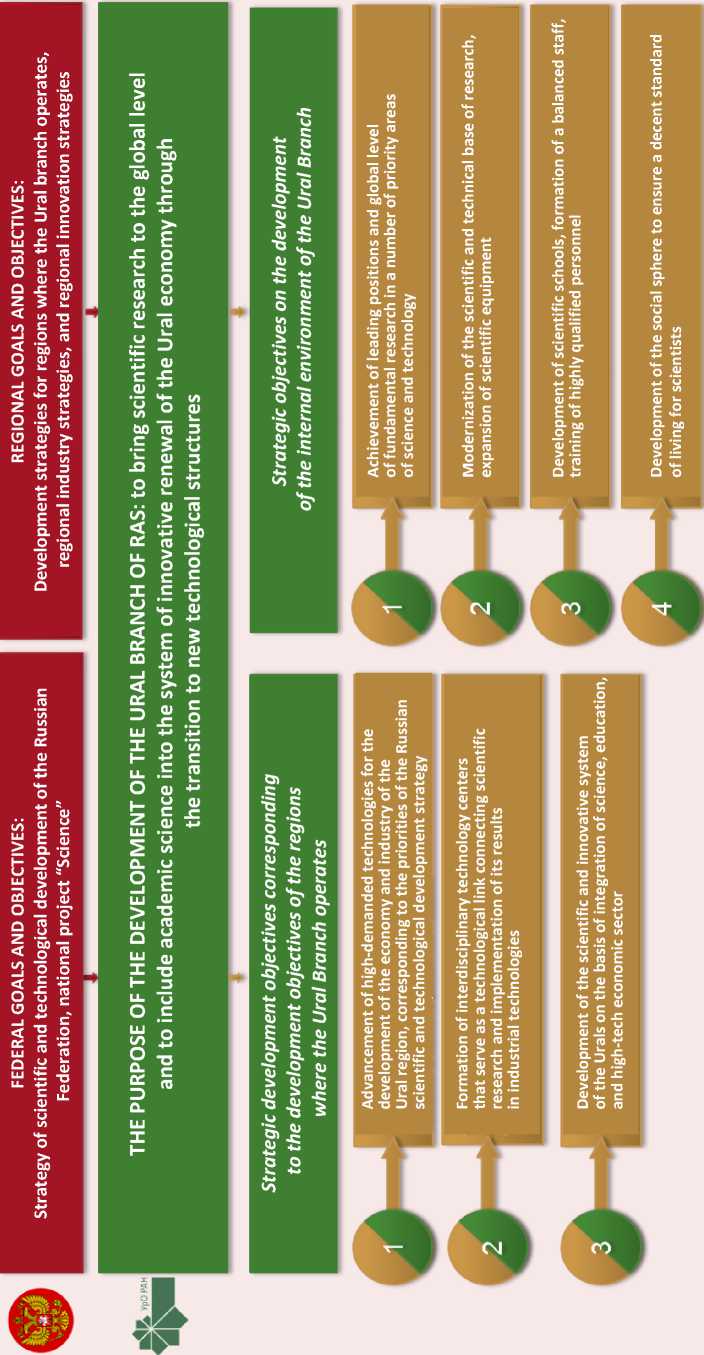
and neighboring regions, the authors justified 6 priority directions of development of the Ural Branch of RAS :
-
1. Digitalization of industrial enterprises.
-
2. Creation of new industrial technologies and materials.
-
3. Development of “green” technologies and security.
-
4. Improvement of demography and public health.
-
5. Comprehensive development of Arctic territories.
-
6. Socio-humanitarian technologies.
Socio-humanitarian technologies are organic components of these priorities. They provide an effective response to society’s “big challenges”, consider the cooperation between man and nature, people and technologies, social institutions at the current stage of global development, and apply methods of Humanities and Social Sciences.
Priorities of the Ural Branch of RAS are primarily defined by long-term priorities of innovative and technological development of Ural and other regions with the Ural RAS scientific centers , which are related to new industrialization implying increase in the share of economic high-tech sectors and innovative renewal of traditional industrial sectors.
Thus, “Creation of new industrial technologies and materials” is particularly important scientific area of the Ural RAS for industrial Urals. For example, even today, two Ural RAS regions-innovators are in the top 5 Russian regions according to the number of technologies used: Perm Krai and the Sverdlovsk Oblast – 12.4 thousand and 11.3 thousand technologies used in industries of respective regions in 2018.
The most significant results of the Ural RAS research institutes are in the following areas of high-tech industrial technologies: laser and plasma, functional coatings and surface treatment, magnetic materials for energy, magnetic nanostructures and materials / element base of nano-spintronics, devices and methods of non-destructive testing, precision metallurgy and pressure processing, digital modeling of materials, etc. Special attention should be paid to the possibility of industrial implementation of rapidly developing laser and plasma additive technologies and postprocessing technologies of formed products, as well as technologies of obtaining different-grade powders (refractory, non-ferrous metals, wear-and corrosion-resistant alloys) used in additive technologies. In addition, the Strategy of socio-economic development of the Ural Federal District and the Russian Federation assigns a key role to the development of modern chemical technologies for the creation of promising organic materials for multi-purpose aims.
Broad and efficient participation of institutions, under scientific and methodical guidance of the Ural RAS, in creating and bringing of innovative technologies of goods and new materials’ production and processing to industrial implementation is currently constrained by the lack of interinstitutional academic technology centers. An obvious competitive advantage of academic technology centers is the possibility of combining the efforts of the Ural RAS various institutes for creation of fundamentally new technologies by integrating individual technological elements, traditionally used in different fields of knowledge, into single fundamentally new end-to-end technologies, aimed at development of samples and experience batches of high-tech products, demanded in the real economic sector. Creation of a single infrastructure for areas which use technological chains with similar parameters will significantly reduce the cost of technological cycles. The project’s implementation will allow bringing the results of breakthrough developments in the field of new materials and technologies of the Ural RAS institutes to the stage of industrial production in interests of high-tech industries, the military-industrial complex, and for the purpose of import substitution. The project envisages the formation of a consortium that includes a number of the Ural RAS ininstitutions of material science profile, located in Ekaterinburg, and a newly created Ural RAS Technology center of advanced materials: a separate technological building should be built for it.
The developed Comprehensive development plan for the Ural Branch of RAS includes an assessment of the total cost and several scenarios for its implementation.
The total cost of the Comprehensive development plan implementation of the Ural department of the Ural Branch of RAS is 63.6 billion rubles. The largest area is “New technologies and materials”, which accounts for 64.0% of costs (Tab. 3).
Total expenditure for the creation of interdisciplinary research centers is 53443.5 million rubles (84.0%), and 10188.6 million rubles (16.0%) are spent on fundamental and applied projects.
Among RF entities, territories of which have the Ural RAS scientific organizations ( Tab. 4 ), the Sverdlovsk Oblast has the largest share – 53.2 billion rubles (83.6%).
Expected results of the Comprehensive development plan implementation are largely determined by the financial model of providing planned innovative projects .
The inertial scenario (1) will be implemented if the existing model of financing with the predominance of budget financing of programs and projects through the system of state tasks is maintained. The expected results for research and organizational activities will be in the range of 2–5% annual growth.
Table 3. Preliminary amount of expenses for the implementation of the Comprehensive development plan of the Ural Branch of RAS within scientific priorities
|
Scientific priorities of the Ural Branch of RAS |
Expenses, million rubles |
|
Digitalization of industrial enterprises |
2 000.0 |
|
Creation of new industrial technologies and materials |
40 751.4 |
|
Development of “green” technologies and security |
6 696.5 |
|
Improvement of demography and public health |
5 248.8 |
|
Comprehensive development of Arctic territories |
1 763.5 |
|
Socio-humanitarian technologies |
7 171.9 |
|
Total |
63 632.1 |
Table 4. Preliminary amount of expenses for the implementation of the Comprehensive development plan of the Ural Branch of RAS within territories
|
Territory |
Expenses, million rubles |
|
Yekaterinburg, Sverdlovsk Oblast |
53223.6 |
|
Perm, Perm Krai |
5144.8 |
|
Syktyvkar, Komi Republic |
3016.0 |
|
Arkhangelsk, Arkhangelsk Oblast |
896.1 |
|
Izhevsk, Udmurt Republic |
979.8 |
|
Orenburg, Orenburg Oblast |
358.5 |
|
Chelyabinsk, Chelyabinsk Oblast |
13.3 |
|
Total |
63 632.1 |
The accelerated scenario (2) means an increase of research funding and the implementation of the Ural RAS most innovative projects. The indicators of publication, patent and innovation activity of the Ural RAS will grow by of 5–10% annually. At the same time, the source of increased funding will play a major role in this process. With the growth of extra-budgetary financing at the expense of technology customers (2a) , the accelerated scenario will be associated with a predominant increase of the studies’ number and the volume of its implementation. The accelerated scenario, due to the inclusion of Ural RAS in the “Science” national project (2b), will lead to an increase of the basic studies’ quality, their upbringing to the highest level, and simultaneous increase of applied studies for industrial customers.
The breakthrough scenario (3) will be implemented with a simultaneous increase of the volume of extra-budgetary funding from industrial customers and the inclusion of the Ural RAS in the national project “Science”. It will allow making a significant scientific breakthrough by creating world-class centers, implementing innovative fundamental and applied projects, upgrading equipment, and attracting talented personnel.
The expected results are based on the accelerated scenario. They include: creation of world-class centers on the basis of the Urals’ leading scientific institutions and higher educational institutions (at least 2); creation of the Ural scientific and educational center on the basis of academic institutions and leading scientific schools of the Urals and other regions; upbringing of publication activity and quality of publications to the level of advanced foreign countries; updating of scientific equipment (at least 50%); implementation of joint international projects, primarily within the framework of ASNTRK; creation of more than 40 new laboratories with active participation of scientific youth; increase of the number of young researchers under the age of 39 to 45%; construction and transfer of 6000 square meters of living space to the Ministry of Science and Higher Education of the Russian Federation in the form of office housing for academic institutions.
Conclusions
The generation, dissemination, and rational use of new knowledge and technologies after the implementation of research potential directly affect the socio-economic development of the region and its long-term efficiency. The study established a positive correlation (without time lags) of the key indicator of region’s socioeconomic development – per capita GRP – with the following indicators of research potential: a number of researchers, a number of scientific organizations, researchers’ salary fund and the share of researches’ budget financing.
The correlation with delayed returns with a one-year lag is observed in the “research and development costs” and “internal research and development costs at the expense of the federal budget” indicators. The correlation with advanced one-year lag is observed in the “share of innovative products”, “patents for inventions per researcher”, “developed technologies per researcher” indicators. On the one hand, the knowledge and technologies created in this region might be used in the production of products and services and ensure productivity growth and costs’ reduction. On the other hand, results of the use of research potential in the form of prepared technologies and specific results of intellectual activity ensure the innovation of products and services, increase their competitiveness on national and global markets. Today, the research sector, which produces new knowledge and transforms it into innovative products, grows faster. It becomes the engine of regional intensive economic growth.
The article develops theoretical concepts that characterize the scientific and innovative spheres of the economy. The research potential, as an element of scientific and technological potential, associated with the segment of fundamental and applied research, implemented by scientific organizations, was identified. The results’ practical significance is the justification of the regions’ comparative analysis’ methodology according to the level of research potential and its contribution to the socio-economic development of the region.
The development of science has a significant impact on bridging the gap between Russia and developed countries. It also provides national security, not only because the science sector creates breakthrough technologies, necessary for the development of the industrial complex and the innovative economy, but also because it gives jobs, increases productivity and wages, creates social conditions for economic stability27. At the same time, the economy of the Russian Federation entities, which have a high level of research potential development, is more competitive and attractive for investments. Such regions are characterized by high labor productivity and average per capita income indicators, positive GRP dynamics, and low unemployment.
However, a high concentration of scientists and researchers in the region is a necessary but insufficient condition for ensuring economic development with the help of knowledge and technology. The most important prerequisite for generating knowledge and creating breakthrough technologies is a high concentration of investment resources. As the experience of developing a Comprehensive development plan for the Ural Branch of RAS has shown, in order to achieve these ambitious goals, investments into capital construction, instrument base update, and large-scale digitalization of research processes are required. Another necessary condition is the creation of the environment for attracting private capital to science, formation of industrial partners’ economic motivation for participation in research and development conducted by state science institutions.
Список литературы Research potential of the Ural branch of the Russian Academy of Sciences as a strategic factor in regional development
- Savinkov V.I., Baklanov P.A. Rol' nauki v razvitii innovatsionnogo proizvodstva: ekspertnaya otsenka [The role of science in the development of innovative production: expert assessment]. Moscow: TsSPiM, 2016. 140 p.
- Zadumkin K.A., Kondakov I.A. Nauchno-tekhnicheskii potentsial regiona: otsenka sostoyaniya i perspektivy razvitiya [Scientific and technical potential of the region: Assessment of the state and prospects of development]. Vologda: ISEDT RAS, 2010. 205 p.
- Interim Report on the OECD Innovation Strategy. An Agenda for Policy Action on Innovation. Paris: OECD, 2009.
- Todosiichuk A.V. The intellectual potential of society, the effectiveness of science and economic growth. Innovatsii=Innovations, 2010, no. 1 (135), pp. 35-42. (In Russian).
- Ustenko V.S., Folom'ev A.N., Kushlin V.I. Innovatsionnoe napolnenie investitsionnoi politiki: monografiya [Innovative content of investment policy: Monograph]. Ed. by V.I. Kushlin. Moscow: Prospekt, 2016. 240 p.
- Avdulov A.N., Kul'kin A.M. Indicators of scientific and technical potential. Methods of comparative analysis. Kur'er rossiiskoi akademicheskoi nauki i vysshei shkoly=Courier of Russian Academic Science and Higher Education, 2001, no. 12. (In Russian).
- Mindeli L.E., Khromov G.S. Research and technical potential of Russia. Moscow: TsISN, 2003, 122 p.
- Kochetkov S., Kochetkova O. Innovative potential of industry: spatial boundaries of economic development. Ekonomist=Economist, 2019, no. 1, pp. 24-31. (In Russian).
- Khairullina M.V. Technological entrepreneurship: constraints and conditions for development. Rossiiskoe predprinimatel'stvo=Russian Business, 2016, vol. 17, no. 16, pp. 1831-1848. (In Russian).
- Akberdina V.V., Grebenkin A.V., Bukhvalov N.Y. Simulation of innovative resonance in the industrial regions. Ekonomika regiona=Economy of Region, 2015, no. 4, pp. 289-308. 10.17059/2015-4-23 (In Russian).
- DOI: 10.17059/2015-4-23(InRussian)
- Donichev O.A., Fraimovich D.Yu., Grachev S.A. Regional system of economic and social factors of formation of innovative development resources. Ekonomicheskie i sotsial'nye peremeny: Fakty, tendentsii, prognoz=Economic and Social Changes: Facts, Trends, Forecast, 2018, vol. 11, no. 3, pp. 84-99. 10.15838/esc.2018.3.57.6 (In Russian).
- DOI: 10.15838/esc.2018.3.57.6(InRussian)
- Solov'ev D.B., Kuzora S.S. Methodology for evaluating innovation activity by means of flexible algorithms. Innovatsii=Innovations, 2019, no. 6, pp. 12-24. (In Russian).
- Technology Readiness Level. National Aeronautics and Space Administration USA. Available at: https://www.nasa.gov/directorates/heo/scan/engineering/technology/txt_accordion1.html (accessed: 13.12.2019).
- Methodology for determining the readiness levels of technologies within FTP projects "R&D for priority areas of the development of S&T complex of Russia" approved by the Ministry of Science and Higher Education of the Russian Federation, decree no. ГТ-57/14vn. Available at: http://fcpir.ru/upload/medialibrary/955/gt_57_14vn_metodika-ugt-_002_.pdf (accessed: 13.12.2019) (In Russian).
- Bendikov M.A., Khrustalev E.Yu. Methodological bases of research of the mechanism of innovative development in modern economy. Menedzhment v Rossii i za rubezhom=Management in Russia and Abroad, 2007, no. 2, pp. 314. (In Russian).
- Samovoleva S.A. Absorption of technological knowledge as a factor of innovative development. Voprosy Ekonomiki=Economic Issues, 2019, no. 11, pp. 150-158. 10.32609/0042-8736-2019-11-150-158 (In Russian).
- DOI: 10.32609/0042-8736-2019-11-150-158(InRussian)
- Rumyantsev A.A. Scientific and innovative activity in the region as a factor of its sustainable economic development. Ekonomicheskie i sotsial'nye peremeny: Fakty, tendentsii, prognoz=Economic and Social Changes: Facts, Trends, Forecast, 2018, vol. 11, no. 2, pp. 84-99. 10.15838/esc.2018.2.56.6 (In Russian).
- DOI: 10.15838/esc.2018.2.56.6(InRussian)
- Daejeon Declaration on Science, Technology, and Innovation Policies for the Global and Digital Age. Available at: https://www.oecd.org/sti/daejeon-declaration-2015.htm (accessed: 20.11.2019).
- Global Innovation Index 2019. Available at: https://www.wipo.int/publications/ru/details.jsp?id=4434&plang=RU (accessed: 20.11.2019).
- The innovation imperative of manufacturing. Available at: http://www.themanufacturinginstitute.org/~/media/6731673D21A64259B081AC8E083AE091.ashx (accessed: 20.11.2019).
- European innovation scoreboard. Available at: https://ec.europa.eu/growth/industry/innovation/facts-figures/scoreboards_en (accessed 20.11.2019).
- EBRD Knowledge Economy Index. Available at: https://www.ebrd.com/news/publications/brochures/ebrd-knowledge-economy-index.html (accessed: 20.11.2019).
- The Innovation Capacity Index: Factors, Policies, and Institutions Driving Country Innovation. Available at: https://www.researchgate.net/publication/280051943_The_Innovation_Capacity_Index_Factors_Policies_and_Institutions_Driving_Country_Innovation (accessed: 20.11.2019).
- The Bloomberg Innovation Index. Available at: https://www.bloomberg.com/graphics/2015-innovative-countries/ (accessed: 20.11.2019).
- Fedorova E.V. Foreign methods of countries and regions' innovation activity rating. Infrastrukturnye otrasli ekonomiki: problemy i perspektivy razvitiya=Infrastructural Sectors of the Economy: Problems and Prospects of Development, 2013, no. 1, pp. 95-107 (In Russian).
- Federal system for monitoring the performance of scientific organizations, conducting research, development and technological work (FSMNO). Available at: https://www.sciencemon.ru/ (accessed: 20.11.2019) (In Russian).
- Popov E.V., Vlasov M.V., Shishkina A.Yu. The methodology for the quantitative assessment of the knowledge generation. Ekonomicheskii analiz: teoriya i praktika=Economic Analysis: Theory and Practice, 2015, no. 22 (421), pp. 36-44. (In Russian).
- Komarov A.V., Petrov A.N., Sartori A.V. Model of integrated assessment of technological readiness of innovative scientific and technological projects. Ekonomika nauki=Economics of Science, 2018, vol. 4, no. 1, pp. 47-57. 10.22394/2410-132X 2017 4 1 47 57 (In Russian).
- DOI: 10.22394/2410-132X2017414757(InRussian)
- Orlov A. Scientometric methods of analysis and evaluation of scientific results from the position of science controlling. Ekonomist=Economist, 2019, no. 2, pp. 45-58. (In Russian).
- Yur'evich M.A. Ratings of scientific organizations. Sociologiya nauki i tekhnologii=Sociology of Science and Technology, 2018, vol. 9, no. 4, pp. 66-79. (In Russian).
- Forecast of long-term socio-economic development of the Russian Federation until 2030. Available at: http://economy.gov.ru/minec/activity/sections/macro/prognoz/doc20130325_06 (accessed: 20.11.2019) (In Russian).
- Akberdina V.V., Grebenkin A.V., Smirnova O.P. Comprehensive assessment of industries economic security: regional aspect. Ekonomika regiona=Economy of Region, 2017, no. 4, pp. 1264-1279. 10.17059/2017-4- 23 (In Russian).
- DOI: 10.17059/2017-4-23(InRussian)

